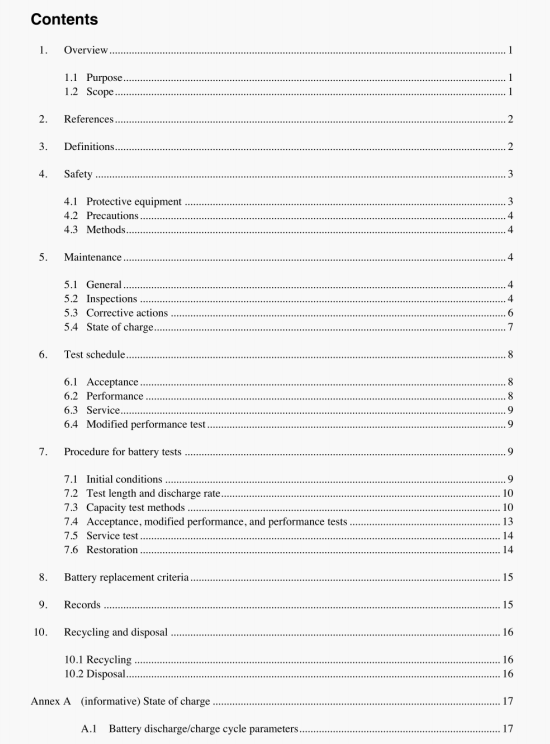IEEE 450:2002 pdf free download.IEEE Recommended Practice for Maintenance, Testing, and Replacement of Vented Lead-Acid Batteries for Stationary Applications.
6.1 Acceptance
An acceptance test of the battery capacity (see 7.4) should be made, as determined by the user, either at the factory or upon initial installation. The test should meet a specific discharge rate and be for a duration relating to the manufacturers rating or to the purchase specifications requirements.
Batteries may have less than rated capacity when delivered. Unless I()% capacity upon delivery is specilied, initial capacity can be as low as )% of rated. Under normal operating conditions, capacity should rise to at least rated capacity in normal service after several years of float operation. (Sec IEEE Std 485-1997.)
Acceptance tests of I hour or less should use the rate-adjusted method of 7.3.2. lIthe aim of the test is to verify performance against manufacturers published data, the rate should not be adjusted for the end of life condition. i.e.. perftwm the test at the full published rate adjusted for temperature. lithe aim is to establish a baseline for future performance testing. adjust the rate for the end of life condition.
6.2 Performance
a) A performance test of the battery capacity (see 7.4) should be made within the first two years of service. It is desirable for comparison purposes that the performance tests be similar in duration to the battery duty cycle.
b) Batteries should undergo additional performance tests periodically. When establishing the interval between tcsts, factors such as design life and operating temperature (see Annex H) should be considered. It is recommended that the performance test interval should not be greater than 2591 of the expected service life.
c) Annual performance tests of battery capacity should be made on any battery that shows signs of degradation or has reached 85% of the service life expected for the application. Degradation is indicated when the battery capacity drops more than 10% from its capacity on the previous performance test. or is below X)% of the manufacturers rating. lithe battery has reached 8591 of service life, delivers a capacity of l(E91 or greater of the manufacturer’s rated capacity. and has shown no signs of degradation. performance testing at two-year intervals is acceptable until the battery shows signs of degradation. If capacity is calculated by the rate-adjusted method (see 7.3.2.2. degradation can be indicated by a capacity drop of le.s than 1091 from the previous test, depending on the discharge rate. Contact the manufacturer for further guidance.
d) If performance testing is to be used to reflect baseline capacity or benchmark (the most accurate form of battery trending) capacity of the battery, then perform requirements a) through 0 of 7.1. If performance testing is to be used to reflect maintenance practices as well as trending.
IEEE 450:2002 pdf free download
